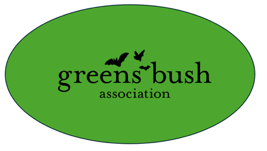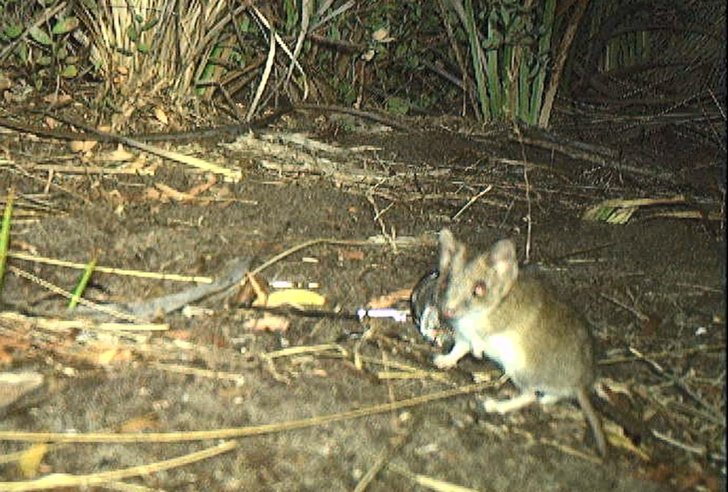Greens Bush Association Guided Walk
 As part of our ‘Delving Deeper into Greens Bush’ series of educational walk & talks, Greens Bush Association (GBA) recently carried out a guided walk in Greens Bush (GB) with our Parks Victoria (PV) ranger, Kim Cott. & GBA organisers, Virginia Carter & Mark Mooney.
As part of our ‘Delving Deeper into Greens Bush’ series of educational walk & talks, Greens Bush Association (GBA) recently carried out a guided walk in Greens Bush (GB) with our Parks Victoria (PV) ranger, Kim Cott. & GBA organisers, Virginia Carter & Mark Mooney.
The aim of the walk was to showcase & discuss the extent & overall strategy of restoration works occurring throughout GB. A map highlighting all works was displayed & discussed at different points of the walk. Much information was shared on the day, but to summarise: there’s a lot going on in GB!
- PV’s strategic plan of bushland works for GB is to protect the areas of highest value (vegetation quality & habitat values) & to link with the broader Biolink projects occurring in the surrounding areas outside the National Park

- PV are carrying out pest animal projects in GB targeting foxes, cats & deer
- PV have been carrying out extensive fauna monitoring in GB since 2011, now in partnership with Bunurong Land Council. Preliminary results show positive recovery of native fauna populations & highlights the importance of GB for significant species such as White-footed Dunnart, Dusky Antechinus, Lewins Rails, Koala, Swamp Skink & Southern Toadlet. Results of recent monitoring will be published soon.
- GBA works are aimed at consolidating/expanding/connecting PV works, protecting habitat, mapping & monitoring sites, education & collaborating with all beings of the area
- GBA volunteer works include woody weed control, an annual Ragwort & Disa (South African Orchid) control program & the removal of dilapidated fencing posing risks to wildlife
- GBA restoration works have covered a total of 65 hectares.
See attached map representing the extensive bushland restorations works occurring in GB 2024/2025. The colour codes relate to different projects & are for PV internal planning. The lime-green & pink sites are our GBA works.

Examples of the fauna footage captured during PV’s monitoring will be showcased on GBA’s Facebook page.
We meandered through GB intersecting some of the active work sites, then delved off-track deep into one of the tributaries of Main Creek to observe a long-term, on-going restoration site. Here we observed the abundant regeneration of native vegetation over many years of staged weed control & follow-up weed control amongst different vegetation types; Swampy Woodland, Riparian Scrub, Gully Woodland & Damp Sands Herb-Rich Woodland. Once dense with woody weeds, thistles, ragwort & blackberry, the tributary is now thriving with a diversity of riparian species including tree ferns, rushes, sedges, herbs, creepers, paperbarks, blackwood’s & much more.
We then visited an adjacent site where the weeds have not yet been treated, observing the devastating effects of mature woody weeds on the riparian vegetation. The ferns, sedges & herbs had been smothered, the mid-storey out-competed & canopy species were showing signs of stress. Works will be continuing at this site working from the higher quality areas, adjacent to previous work sites.
Bushland restoration principals & techniques were demonstrated & discussed at these sites. With the extremely limited resources allocated to protecting our native flora & fauna & such extensive threats to biodiversity, it is important that our restoration works are well planned, strategic & long-term to ensure works are effective & maintain the integrity of our bushland.
Key points discussed were:
- Observe & learn the land, flora & fauna – all vegetation is habitat.
Understanding the habitat values of the site no matter how ‘weedy’ is integral to planning works. What is the fauna relying upon for protection, food & nesting sites? We can get tied up in the urgency to weed, these very weeds are often supporting our remaining fauna & some weeding may be detrimental to the habitat values of the site. Every action has a reaction, educate yourself to be able to predict the implications of the works, ensuring the habitat values of the site are retained & improved.
- Make minimal disturbance
The aim of bushland restoration is to encourage the regeneration of our native species. Disturbance of the site is often the reason weeds have proliferated. Use sensitive weed control techniques & ensure minimal, if no off-target/damage to our native species. Work gently & slowly, observing the effects of the works.
- Always protect the most diverse & highest quality native vegetation
This is the most valuable work, retaining & restoring high quality bushland. Consolidate these areas & expand works out from there, this allows recruitment of native species into your next area of works & protects our most precious remnants.
- Never over clear
Over clearing can rapidly denude the habitat values of a patch of bushland. Imagine all of the insects, reptiles, frogs, birds, mammals that have come to rely on the remaining wild vegetation, adapting to the altered conditions. Over clearing can often encourage the next swathe of weeds to enter the site.
- Follow-up works
Once a site has been weeded the area needs to be monitored and managed. Once weeds are treated, seeds remaining in the soil will regenerate, plan to follow up & consolidate all works before commencing new projects
- Identify & target isolated infestations of highly invasive species
If there are isolated patches of highly invasive species, prioritise controlling to prev ent further spread throughout the entire site. An example in GB is English Ivy, where only small emerging infestations occur that we know of. These sites are treated easily by hand weeding & mapped for future follow-up. This plant, if left untreated can form a monoculture, smothering ground-cover & destroying canopy species.
White-footed Dunnart
GBA & PV are extremely appreciative of our volunteers, we look forward to continuing these works & seeing you at our next activity. Come along & join in to help protect our magnificent Greens Bush. Learn about our local flora & fauna, bushland restoration principals/techniques & meet your fellow local, bushland enthusiasts.
GBA meet on the 2nd Saturday of the month.
To receive notifications of all our activities, become a member.
Go to http://www.parkconnect.vic.gov.au create a profile & join
Greens Bush Association
or email localhabitat@gmail.com
Follow us on Facebook https://www.facebook.com/greensbushassociation/
– Article by Virginia Carter, Mark Mooney, and Kim Cott – Animal images mage provided by Parks Victoria as part of the ‘Signs of Healthy Parks’ fauna monitoring program. Video footage captured on ScoutGuard and Reconix monitoring cameras. (Wildlife Act Research Permit #10009952)